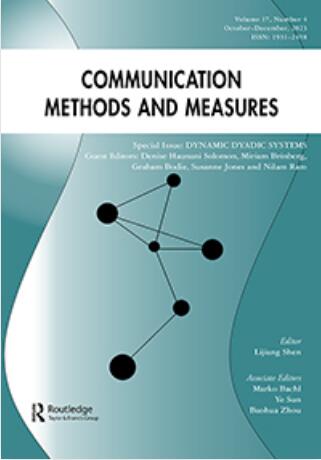传播科学测量量表的α系数和可靠性:关于 Hayes 和 Coutts 的说明
IF 3.7
1区 文学
Q1 COMMUNICATION
引用次数: 0
摘要
本说明旨在对 Hayes 和 Coutts(2020 年)最近的讨论进行补充,重点是:(i) 系数α和信度的人口特征的载荷相等条件;(ii) 系数α和信度的人口特征的载荷相等条件;(iii) 系数α和信度的载荷相等条件。本文章由计算机程序翻译,如有差异,请以英文原文为准。
Coefficient alpha and reliability of communication science measurement scales: A note on Hayes and Coutts
This note intends to complement the recent discussion in Hayes and Coutts (2020) by focusing on (i) the loading equality condition for the population identity of coefficient alpha and reliability o...
求助全文
通过发布文献求助,成功后即可免费获取论文全文。
去求助
来源期刊

Communication Methods and Measures
COMMUNICATION-
CiteScore
21.10
自引率
1.80%
发文量
9
期刊介绍:
Communication Methods and Measures aims to achieve several goals in the field of communication research. Firstly, it aims to bring attention to and showcase developments in both qualitative and quantitative research methodologies to communication scholars. This journal serves as a platform for researchers across the field to discuss and disseminate methodological tools and approaches.
Additionally, Communication Methods and Measures seeks to improve research design and analysis practices by offering suggestions for improvement. It aims to introduce new methods of measurement that are valuable to communication scientists or enhance existing methods. The journal encourages submissions that focus on methods for enhancing research design and theory testing, employing both quantitative and qualitative approaches.
Furthermore, the journal is open to articles devoted to exploring the epistemological aspects relevant to communication research methodologies. It welcomes well-written manuscripts that demonstrate the use of methods and articles that highlight the advantages of lesser-known or newer methods over those traditionally used in communication.
In summary, Communication Methods and Measures strives to advance the field of communication research by showcasing and discussing innovative methodologies, improving research practices, and introducing new measurement methods.
 求助内容:
求助内容: 应助结果提醒方式:
应助结果提醒方式:


